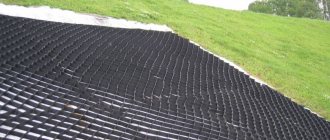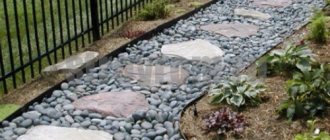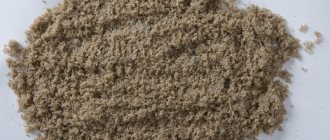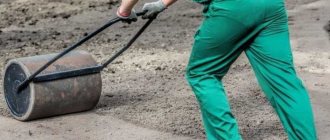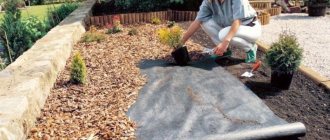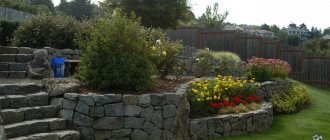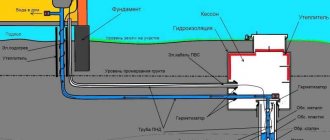To reinforce the soil and separate layers in road construction, a special geogrid is indispensable, which prevents erosion and increases the strength of the road base. The use of geomaterial has an economic effect, because the cost of the mesh is much lower than laying an additional layer of asphalt concrete pavement. Synthetics are used not only in road work, but also in strengthening the foundations of hydraulic structures, as well as in a number of other works.
Geogrid for soil, depending on the brand and series, is made of polyester, polyamide, polypropylene and fiberglass. The synthetic consists of cellular modules that are coated with impregnation to protect against aggressive environments and provide better adhesion to asphalt; some mesh models are supplemented with a geotextile backing.
How to strengthen a ditch: basic methods
If a dacha or country house is located in an area with difficult terrain, soil or snow debris may move down from the top point. Very often during rains, dirt, leaves, and roots flow down the slope.
Rainfall or melting snow can damage flower beds or plantings below. To avoid such problems, you need to strengthen the slope.
Basically, the need to strengthen the slope arises in areas with mountain ranges, ravines and forest areas.
Methods for strengthening slopes:
- Bushes and flower beds. To strengthen the slope, plants with a well-developed root system are often planted. Suitable perennial plants are cedar or pine, lilac, hawthorn, blackberry and raspberry bushes, and tree peonies. Effective on soil slopes up to 8 degrees.
- Support in the form of a fence made of brick or concrete slabs. The fences are durable and do not interfere with the growth of flowers and bushes. You can decorate the fence with a flower bed or street lamps.
- Strengthening with large stones. Large boulders are laid out along the slope, which will keep the soil from crumbling. You can also use decorative logs dug into the ground.
- Biomats. Suitable for strengthening slopes up to 70 degrees. The materials are applied to a surface cleared of large stones and fixed at the edges. Plant seeds are planted around the entire perimeter, which germinate and adhere to the fibers of the mat.
- Geotextiles, geomats and geogrid. They work according to the same principle - they are laid on the surface, forming an even layer.
The choice of material for strengthening the soil depends, first of all, on the angle of inclination of the earth and its area. Working with the design of slopes does not require special skills, but it is recommended to approach the design clearly and seriously calculate the required amount of material and fasteners in advance.
Geogrid for landscape design
Geogrid is used to strengthen slopes, as well as prevent landslides and increase the durability of various artificial unevenness. To install it, the top part of the soil along with the turf is removed, after which the area is leveled. The gratings are secured using dowels or anchors, as well as various clamping structures. Then they are filled with soil—imported fertile soil can also be used—and they are also covered with turf. The advantage of geogrid is its unique design, which allows you to plant shrubs or small trees in cells, which also help strengthen the slopes.
Drainage ditch: device features
During heavy downpours or frequent rains, water accumulates on the site and stands on the surface. Due to underground groundwater, precipitation is not absorbed into the soil, so you need to find a way to dry the surface. One of the accessible and effective methods of soil drainage is a drainage ditch.
The drainage trench system is often used in areas with minimal slope, where water constantly stagnates after rain.
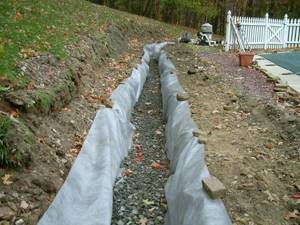
For areas with a strong slope, drainage will help prevent the displacement of fertile soil and washing away of plants growing in the dacha area.
To strengthen a ditch in your dacha, you can use the most ordinary car tires, cut into several parts. Each piece is placed in a dug ditch, forming a U-shaped pipe. Excess water will flow down it.
Construction with geogrid
Geogrid is indispensable when creating large objects on uneven terrain. It can be laid on the slopes of hills and other uneven surfaces, preventing them from collapsing under the pressure of building structures. In addition, the geogrid helps stabilize the fill soil used to fill sinkholes.
This geosynthetic material is also useful when building on a weak foundation, such as marshy soil or sandy soil. The volumetric lattice allows you to increase its load-bearing capacity several times, preventing the destruction of the building in the future and reducing the cost of major repairs.
Drainage mesh to strengthen slopes
Drainage mesh is a grid made of polymer material with diamond-shaped cells that provides surface strengthening and good water drainage. The material from which the mesh is made does not rot, and it is not afraid of garden pests and other microorganisms.
Depending on the area of use, the mesh protects the surface from large debris - leaves, twigs and lumps of dirt.
To strengthen the slope, a geomat is used, which includes a drainage mesh framed with layers of geotextile. The mat is firmly fixed to the surface, delaying the slope from destruction.
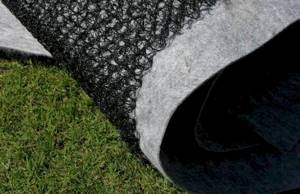
Advantages of the drainage mat:
- The slopes are strengthened firmly and for a long time;
- Easy to install and does not require special tools;
- Tolerates temperature changes well;
- Not afraid of fungus and does not rot;
- Environmentally friendly material.
Drainage mats are used both to strengthen the soil on slopes and in construction work to protect the foundation and basement from underground groundwater. The mat is also used to strengthen shoulders on highways and steep slopes at sports fields and stadiums.
Application area of geogrid
Geosynthetic mesh is used in a wide range of applications and is in demand in road and industrial construction, as well as in landscaping and landscape design. The main areas of application of geomaterial are:
- Strengthening dams, slopes and slopes,
- Reinforcement of retaining walls and road layer,
- Soil protection from erosion,
- Protection of roads in the mountains from rockfalls.
In road work, geogrid strengthens the base of the roadbed and allows it to last longer without repair; in addition, it increases the characteristics of the road in terms of the permissible load on the roadbed. The material is used to strengthen retaining soil walls, while the mesh allows you to work with heterogeneous and weak soils.
The economic effect is achieved by combining an increase in soil stability and a reduction in the volume of bedding used. The economic feasibility is confirmed by accurate calculations and is based on real figures, and not on the speculation of geomaterial manufacturers.
How to level a ditch with slate: step-by-step instructions
Many summer residents have determined that the simplest and most economical way to strengthen the walls of a drainage ditch is to fence its walls with slate.
Strengthening slopes with slate is a short-lived and not particularly attractive external fencing, but, despite its shortcomings, it copes with its duties quite well.
To lay slate along the ditch you will need a grinder, a respirator, a shovel and metal rods.

Progress:
- Cut the slate sheets into equal pieces. When cutting slate with a grinder, be sure to use a respirator and goggles to protect your face from dust.
- Depending on the angle of the ditch, use a shovel to bury the slate along the walls. Pieces of wavy slate are placed on top of each other, flat pieces are placed end-to-end.
- To prevent the slate from moving, secure it on both sides with metal rods. They are driven into the ground to a depth of 50-60 cm.
- It is better to paint the rods with paint or an anti-corrosion compound.
The drainage ditch through which water will flow can be directed into a specially equipped well. The accumulated natural water will be useful for watering the garden during particularly dry seasons.
Advantages of the Armplast geogrid
- Reduces the amount of work and labor costs by up to 50% Reduces the amount of work and labor costs by up to 50%, while allowing to reduce direct costs for traditional types of fortifications by 20-30%
- Strength of the material When producing a geogrid, the connection is made by welding seams using laser bonding, which can significantly increase the strength of the material. With standard needle stitching, excessive perforation occurs, which, accordingly, reduces the tearing characteristics
Examples of strengthening ditches in a summer cottage (photo)
- Author: admin
Rate this article:
- 5
- 4
- 3
- 2
- 1
(0 votes, average: 0 out of 5)
Share with your friends!
Volumetric geogrid
To effectively strengthen soil and steep slopes, three-dimensional geogrids are used - structures made of polymer tapes welded together in a checkerboard pattern. When stretched, the geogrid forms a stable horizontal and vertical base designed to fix the filler (sand, crushed stone, concrete, plant soil, etc.). Thanks to its flexibility, the lattice easily follows the shape of the relief. Reinforcing the slopes of lakes, rivers and canals using a three-dimensional geogrid will allow you to forget about the problems of washing away the banks for a long time.
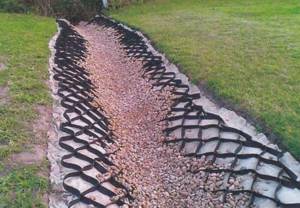
Reinforcing the slopes of lakes, rivers and canals using a three-dimensional geogrid will allow you to forget about the problems of washing away the banks for a long time
Stages of laying an anti-erosion mat
| 1. The surface of the slope is leveled, if possible, cleared of debris, stones, sticks and other things. |
| 2. At the base and top of the slope, anchor trenches 30 cm deep are dug. The mat is laid with the smooth side down. The upper and lower edges of the mat are secured in the trench with anchors in 1 m increments. It is important that the material lies flat, without folds or waves! Anchor trenches are filled with soil and compacted. For additional fixation, anchors are installed over the entire surface of the slope |
| 3. Sowing of seeds is carried out at the rate of 50 g per 1 m of slope in two stages: 2/3 is sown on mats and 1/3 is after filling the mats with plant soil. In this case, it is possible to use hydroseeding - operations for introducing various emulsions simultaneously with sowing seeds. This method is used for landscaping large areas, as well as for working in hard-to-reach, inconvenient places - on steep slopes, road slopes and wastelands |
| 4. The mat is covered with a layer of plant soil 2-5 cm thick. At high surface water speeds, it is recommended to backfill with crushed stone with a fraction size of 2-6 mm |
In conclusion, a short video that clearly demonstrates the process of laying geogrid:
These articles may also be of interest to you:
- Volumetric geogrid or how to strengthen the soil on a slope
- Is a foundation needed when building a bridge in the garden?
- Geogrid or strengthening of slopes and ravines
- Replacing the siphon and sink drain



